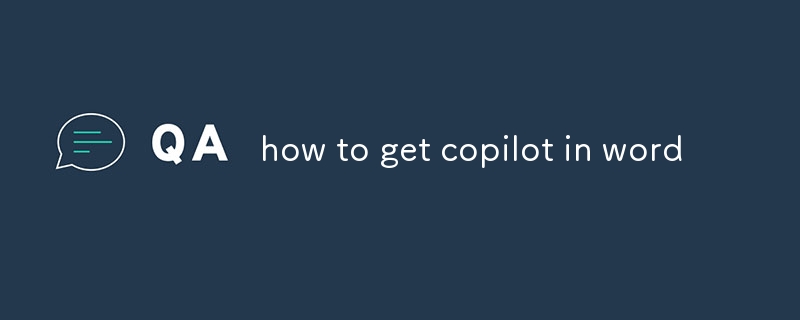Home >Technology peripherals >AI >how to get copilot in word
how to get copilot in word
- DDDOriginal
- 2024-08-16 15:34:19938browse
This article provides a comprehensive guide on enabling and using Microsoft Word's Copilot feature. It explains the prerequisites for using Copilot, such as a Microsoft 365 subscription, and provides step-by-step instructions on activating it. The ar

How to Get Copilot in Word
How do I enable Copilot in Microsoft Word?
To enable Copilot in Microsoft Word, follow these steps:
- Ensure you have a Microsoft 365 subscription that includes access to Copilot.
- Open Microsoft Word and create or open a document.
- Click on the "Home" tab in the ribbon.
- In the "Editing" group, click on the "Copilot" icon (it looks like a chat bubble with a pen).
- Copilot will now be enabled and will appear as a sidebar on the right-hand side of the document.
What are the prerequisites for using Copilot in Word?
To use Copilot in Word, you must meet the following prerequisites:
- Microsoft 365 subscription that includes access to Copilot (such as Microsoft 365 Enterprise or Microsoft 365 Business Standard)
- Word version 2208 or later
- Internet connection
- A modern operating system (Windows 10 or later, or macOS 11 or later)
How can I unlock Copilot's advanced features in Word?
Copilot offers advanced features that require a separate subscription. To unlock these features:
- Click on the "Upgrade" button in the Copilot sidebar.
- Choose a paid subscription plan that suits your needs.
- Once you have subscribed, the advanced Copilot features will be unlocked.
These features include:
- Premium suggestions: Get tailored suggestions based on your writing style and preferences.
- Citation assistance: Automatically generate citations and references.
- Custom vocabulary: Add custom words and phrases to your Copilot dictionary.
The above is the detailed content of how to get copilot in word. For more information, please follow other related articles on the PHP Chinese website!
Related articles
See more- Technology trends to watch in 2023
- How Artificial Intelligence is Bringing New Everyday Work to Data Center Teams
- Can artificial intelligence or automation solve the problem of low energy efficiency in buildings?
- OpenAI co-founder interviewed by Huang Renxun: GPT-4's reasoning capabilities have not yet reached expectations
- Microsoft's Bing surpasses Google in search traffic thanks to OpenAI technology

